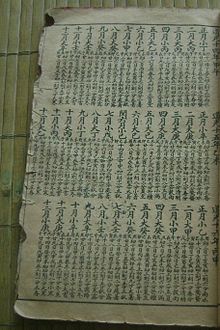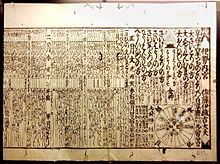
A lunisolar calendar is a calendar in many cultures, incorporating lunar calendars and solar calendars. The date of lunisolar calendars therefore indicates both the Moon phase and the time of the solar year, that is the position of the Sun in the Earth's sky. If the sidereal year (such as in a sidereal solar calendar) is used instead of the solar year, then the calendar will predict the constellation near which the full moon may occur. As with all calendars which divide the year into months there is an additional requirement that the year have a whole number of months. In some cases ordinary years consist of twelve months but every second or third year is an embolismic year, which adds a thirteenth intercalary, embolismic, or leap month.


Their months are based on the regular cycle of the Moon's phases. So lunisolar calendars are lunar calendars with – in contrast to them – additional intercalation rules being used to bring them into a rough agreement with the solar year and thus with the seasons.
The Chinese, Buddhist, Burmese, Assyrian, Hebrew, Jain and Kurdish as well as the traditional Nepali, Hindu, Japanese, Korean, Mongolian, Tibetan, and Vietnamese calendars (in the East Asian Chinese cultural sphere), plus the ancient Hellenic, Coligny, and Babylonian calendars are all lunisolar. Also, some of the ancient pre-Islamic calendars in south Arabia followed a lunisolar system.[1] The Chinese, Coligny and Hebrew[a] lunisolar calendars track more or less the tropical year whereas the Buddhist and Hindu lunisolar calendars track the sidereal year. Therefore, the first three give an idea of the seasons whereas the last two give an idea of the position among the constellations of the full moon.
|
Main article: Chinese calendar |
The Chinese calendar or Chinese lunisolar calendar is also called Agricultural Calendar [農曆; 农历; Nónglì; 'farming calendar'], or Yin Calendar [陰曆; 阴历; Yīnlì; 'yin calendar']), based on the concept of Yin Yang[citation needed] and astronomical phenomena, as movements of the sun, moon, Mercury, Venus, Mars, Jupiter and Saturn (known as the seven luminaries) are the references for the Chinese lunisolar calendar calculations.[citation needed] The Chinese lunisolar calendar is believed to be the origin of some variant calendars used in other neighboring countries, such as Vietnam and Korea.
The traditional calendar calendars used the sexagenary cycle-based ganzhi system's mathematically repeating cycles of Heavenly Stems and Earthly Branches.[citation needed] Together with astronomical, horological, and phenological observations, definitions, measurements, and predictions of years, months, and days were refined. Astronomical phenomena and calculations emphasized especially the efforts to mathematically correlate the solar and lunar cycles from the perspective of the earth,[citation needed] which however are known to require some degree of numeric approximation or compromise.
The earliest record of the Chinese lunisolar calendar was in the Zhou dynasty (1050 BC – 771 BC, around 3000 years ago.[2] Throughout history, the Chinese lunisolar calendar had many variations and evolved with different dynasties with increasing accuracy, including the "six ancient calendars" in the Warring States period, the Qin calendar in the Qin dynasty, the Han calendar or the Taichu calendar in the Han dynasty and Tang dynasty, the Shoushi calendar in the Yuan dynasty, and the Daming calendar in the Ming dynasty, etc. Starting in 1912, the solar calendar is used together with the lunar calendar in China.
The most celebrated Chinese holidays, such as Spring Festival (Chunjie, 春節), also known as the Chinese New Year, Lantern Festival (元宵節), Mid-Autumn Festival (中秋節), Dragon Boat Festival (端午節), and Qingming Festival (清明節) are all based upon the Chinese lunisolar calendar. In addition, the popular Chinese zodiac is a classification scheme based on the Chinese calendar that assigns an animal and its reputed attributes to each year in a repeating twelve-year cycle.
A tropical year is approximately 365.2422 days long and a synodic month is approximately 29.5306 days long,[4] so a tropical year is approximately 365.2422 / 29.5306 ≈ 12.36826 months long. Because 0.36826 is between 1⁄3 and 1⁄2, a typical year of 12 months needs to be supplemented with one intercalary or leap month every 2 to 3 years. More precisely, 0.36826 is quite close to 7⁄19 (about 0.3684211): several lunisolar calendars have 7 leap months in every cycle of 19 years (called a 'Metonic cycle'). The Babylonians applied the 19-year cycle in the late sixth century BCE.[5]
Intercalation of leap months is frequently controlled by the "epact", which is the difference between the lunar and solar years (approximately 11 days). The classic Metonic cycle can be reproduced by assigning an initial epact value of 1 to the last year of the cycle and incrementing by 11 each year. Between the last year of one cycle and the first year of the next the increment is 12 – the saltus lunae (Latin for 'leap of the moon') – which causes the epacts to repeat every 19 years. When the epact reaches 30 or higher, an intercalary month is added and 30 is subtracted. The Metonic cycle states that 7 of 19 years will contain an additional intercalary month and those years are numbered: 3, 6, 8, 11, 14, 17 and 19. Both the Hebrew calendar and the Julian calendar use this sequence.[citation needed]
The Buddhist and Hebrew calendars restrict the leap month to a single month of the year;[citation needed] the number of common months between leap months is, therefore, usually 36, but occasionally only 24 months. Because the Chinese and Hindu lunisolar calendars allow the leap month to occur after or before (respectively) any month but use the true apparent motion of the Sun,[citation needed] their leap months do not usually occur within a couple of months of perihelion, when the apparent speed of the Sun along the ecliptic is fastest (now about 3 January). This increases the usual number of common months between leap months to roughly 34 months when a doublet of common years occurs, while reducing the number to about 29 months when only a common singleton occurs.[citation needed]
An alternative way of dealing with the fact that a solar year does not contain an integer number of lunar months is by including uncounted time in a period of the year that is not assigned to a named month.[6] Some Coast Salish peoples used a calendar of this kind. For instance, the Chehalis began their count of lunar months from the arrival of spawning chinook salmon (in Gregorian calendar October), and counted 10 months, leaving an uncounted period until the next chinook salmon run.[7]
The following is a list of lunisolar calendars sorted by family.